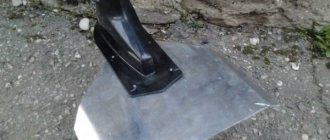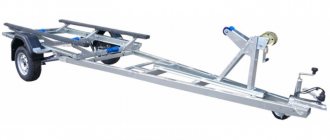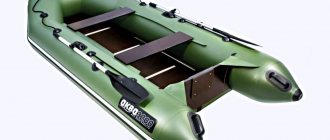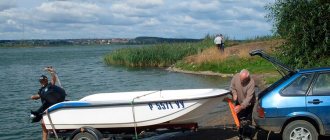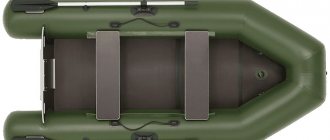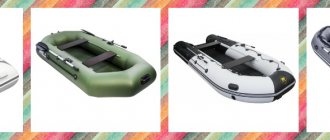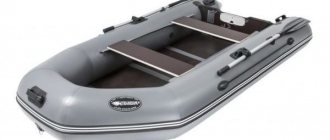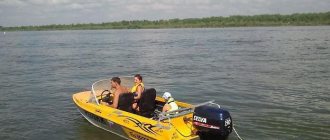Traditional gasoline and diesel engines are gradually being replaced by electric and battery-powered counterparts in a variety of applications. Sometimes such a transition is completely justified, and in some cases - only in certain operational parameters. In the context of equipping water equipment, an electric boat motor provides significant advantages in the form of low noise, higher maneuverability and a lightweight control system. The disadvantages include low performance and, as a consequence, limited use in large bodies of water.
Electric motor device
The complete structure of the unit can be divided into two parts - load-bearing and functional. The first is formed by a rod to which a transom clamp is fixed. The engine propeller and adjustable tiller are attached to the same part. Using a clamp, you can adjust the immersion level of the motor depending on specific operating conditions. The functional part is based directly on the power filling of the engine and control infrastructure. A typical design of an electric boat motor includes a control unit, reverse rotation and wiring for connecting the battery. Moreover, the control relay is interfaced with the engine using a deadwood, the design of which is a metal foot rod.
Features of boat electric motors
- The power source for the electric motor is a battery with a voltage of up to 36 volts. They are divided into:
- starting: for a short period of time, capable of delivering maximum power (with prolonged use there is a possibility of failure)
- traction ones, the operating mode of which even allows for complete discharge without damage to the battery itself.
- Electric motors usually have 5 speeds for forward movement and 3 speeds for reverse.
- Easy to install, maintain and repair.
- Available in models with both manual and foot control.
With manual coordination, speed adjustment, direction of movement and reverse activation are carried out by acting on the handle of the steering device (tiller). The convenience of this type of control is that the engine is always in working condition; all that remains is to set the direction of movement and select the desired speed.
Foot control occurs when the force on the pedal is changed, which gives a faster and more accurate response, increasing the maneuverability of a small boat. With such simple controls, it becomes possible to use a spinning rod or other gear, because in this case your hands remain free.
- Due to the original shape of the blades, coastal vegetation has minimal impact on the propeller, which contributes to faster movement to a given route point.
Batteries for electric motors
Unlike many electric motors used in other applications, boat units do not have mains power capabilities. Therefore, there is only one option for power supply - through the battery pack. There are built-in battery models and portable ones. The first option has extremely limited capabilities for operation, since it is small in size and, accordingly, modest power and the same low operating time on a single charge. Therefore, portable battery models are more often used, which are also divided into starting and traction ones. Most often, an electric boat motor is powered by a traction battery, since it can provide sufficient charge for a long time. However, the structural qualities of the element increase along with the magnitude of the energy potential. Suffice it to say that the mass of the traction battery can reach 25-30 kg.
Advantages of electric motors compared to gasoline ones
- Easy to maintain. There is no need to prepare an oil-gasoline mixture or run to a gas station. The battery is charged from a regular outlet.
- No expenses for gasoline, oil, candles. An hour of running on a gasoline PLM will consume from one and a half liters of gasoline, that is, 50 rubles, and on an electric motor - approximately 500-700 W - 3-4 rubles.
- Small dimensions and weight. The electric PLM is miniature and lightweight - so much so that a fisherman can handle it alone. Electric motors weigh from 2-3 kg, and gasoline motors with similar thrust weigh 7-10 kg. Moving and securing the electric motor is not difficult.
- Silence. Compared even to a 4-stroke PLM, electric motors are much quieter. They do not scare away the fish and do not distract from the beautiful nature.
- No maintenance or winter storage required. You can transport the electric motor in the car in any position - nothing will leak out of it.
- Starts in any water and at sub-zero temperatures. Whereas a gasoline one can fail in winter.
- Relatively low price. Both the device itself and the battery with charger can be cheaper than a gasoline equivalent.
- High maneuverability. With such a PLM, you will maneuver even in the most difficult places, forgetting about the oars. Many models have reverse, which instantly switches to reverse.
- Environmentally friendly. The absence of exhaust gas does not pollute the water body.
Characteristics
The initial calculation of the parameters of the electric motor from the point of view of equipping the boat begins with determining the maximum load. At the initial level, the units are able to withstand loads of about 600-800 kg. The middle segment represents models that work with structures weighing 1000-1500 kg. Next are the performance units, suitable for boats over 1700 kg. As already noted, power is not the strong point of electric engines, but there is also diversity in this indicator. On average, the power potential varies from 0.75 to 4 liters. With.
At the same time, high productivity places its limitations on the operational capabilities of the equipment. For example, the less common power of an electric boat motor is 5-6 hp. With. does not allow entering the planing mode, and also imposes restrictions on access to shallow water. And this is not to mention the loss of one of the main advantages of electric engines, which is low noise level. On the other hand, low-power units will not allow you to cover long distances on the water surface and provide sufficient traction for long boats.
How to choose electric motors for inflatable boats
When talking about motor power, you should take into account the size of the existing watercraft:
- for boats up to 3 meters long and a maximum weight of 500 kg, motors with a thrust of 30 lbs or 0.4 hp are suitable;
- boats from 3 to 4 meters and a maximum weight of up to 900 kg require motors of at least 40 lbs;
- For vessels with a length of 4 meters and a carrying capacity of more than 1000 kg, the most powerful electric motors of 50 lbs and above are needed.
Also, when choosing a motor , you must plan how long it will run without recharging:
- batteries with a capacity of up to 75 Ah can power the engine for 1 day and travel no more than 12 km in 5th gear, and 22 km in first;
- batteries with a capacity of 100 Ah will keep the ship afloat for about 2 days and are capable of traveling up to 26 km in first gear;
- capacity above 100 A/h is not used so often due to its enormous weight (up to 50 kg), high cost and the requirement for a special charger.
Types of electric boat motors
The main classification divides engines based on location. The most common type is outboard units that are fixed to the transom. Usually fastening is carried out using threaded elements, ensuring reliable installation and quick dismantling. Mounted modifications, which are mounted on the cavitation platform of the main motor, are also popular. The result is a combined power plant configuration, in which the leading role is still given to outboard electric motors. Bow-mounted boat engines are less common. They are usually used to equip equipment with rigid bodies. They are the most demanding in terms of installation work and maintenance, but they are also significantly superior in power to their suspended counterparts.
For what purposes can an electric motor be used?
Boats with electric motors are justified not so much by the possibilities of movement (in range or speed), but by the characteristics of the move. Smooth, soft and silent movement through the water is optimal for fishing. For example, the trolling technique cannot be provided by any traditional engine with the same advantages that an electric motor will provide. The same applies to movement in shallow water, where there is a high risk of scaring away the fish with noise. In this case, electric outboard motors for inflatable boats made of polyvinyl chloride are suitable. Both the engine itself and the PVC material will allow you to silently sail to the target location. At the same time, for fishing at great depths and far from the shore in unstable weather, electric power supply for water equipment is simply unsafe. In this case, at a minimum, it is worth acquiring productive units with a capacity of at least 4 liters. With.
Design features
The boat electric motor consists of:
- electrical control circuit, usually combined with a tiller. The latter is equipped with a telescopic handle (almost always) to make it more convenient to make adjustments and effortlessly control all modes. Electric boat motors generally have 4 to 5 speeds for moving backwards and 2-3 rear ones operating in reverse mode;
- the engine itself, which is lowered under water. A continuation of the latter is the screw connected to the rotor. This design makes the motor a simple design that does not require a large number of transmission parts that are subject to wear during operation. In this case, it may be necessary to replace the only part - the current collection brushes.
The electric motor for the boat is connected to the electronics using a rod that is adjustable according to the immersion depth, which gives advantages when moving in shallow water. It also has other advantages: for their manufacture, special metals are used, which are flexible and do not allow the device to receive significant damage when colliding with underwater obstacles.
Electric boat motors are started by pressing a switch once, which takes much less time than it takes to start a fuel unit. Speeds can be switched in both manual and foot modes. This is important for fishermen because their hands remain free.
The operation of electric boat motors is based on the functioning of a rack and pinion mechanism connected via a cable to the pedal, which allows you to change the speed and direction of movement of the craft by pressing your foot. At the same time, you can control it from anywhere.
Some companies (Minn Kota, for example) have gone even further by equipping the outboard motor with a wireless control panel.
Nuances of choice
As you can see, the choice depends a lot on the nature of the operation of the power unit. If you plan to fish at a short distance from the shore, making complex maneuvers, then a low-power electric outboard motor is suitable. How to choose a model for equipment with a rigid body? This option will be closer to the characteristics of gasoline engines, since it will bear a large load. First of all, for such purposes it is worth choosing 4-5 liter models. s., no less. Next, the optimal location for installing the unit is assessed. It is advisable to focus on the nasal installation method, which will further facilitate control and increase the level of safety when driving.
The optional motor support should not be ignored either. The advantages of electrical installations include the ability to connect a wide range of different navigation devices, including GPS receivers. If desired, the electric outboard motor can be equipped with remote controlled control devices.
Electric motors for professional use
If a boat or boat is used to transport tourists, organize excursions or boat trips, then an electric installation may be more profitable than an internal combustion engine. Savings are achieved through lower energy costs and virtually zero maintenance costs.
Installation of an outboard motor for professional use Aquamot on a small catamaran
A comparison shows that during commercial operation of a vessel, switching from a gasoline to an electric engine pays for itself in 1-2 years. However, for this, a professional outboard electric motor must meet certain requirements:
- Have high efficiency - this will allow it to be operated with a battery of smaller capacity, reduce initial costs, charging time and the cost of electricity consumed
- Be simple and reliable - the electric motor must withstand daily intense load and have a minimum of unnecessary functions. Additional features, such as a built-in computer with GPS, increase the price and may cause problems in the future.
- The cost of repairs and maintenance during the operating period should be minimal
A catamaran with an installed electric boat motor is sent to the place of operation
Reliability
The housings of professional boat electric motors are cast from aluminum, and then an additional multi-layer anti-corrosion coating is applied. The shaft is made of stainless steel, and the screw is made of bronze. A sacrificial anode is installed to protect against corrosion.
Powerful electric motors for boats use AC induction motors or BLDC PM electric motors, also called valve motors. The valve motors are powered from pulsed energy sources. In this case, voltage pulses are applied to the stator windings at specified times - at a certain position of the rotor relative to the stator. The position of the rotor is determined by sensors, which, like a switching power supply, in low-power motors are located on a printed circuit board located inside the underwater part of the electric motor.
The green board in the center of the electric motor is an electronic commutator that replaces brushes and rings. On the left is the same board enlarged. When surrounded by water, electronic components sometimes do not work stably and the failure of just one element on the board entails the failure of the entire electric motor. The entire board has to be replaced - this increases the cost of repairs, the downtime of the electric motor and its payback period for professional use
There are no additional electronic components inside the housing of a three-phase asynchronous motor. Only the bearings and windings affect the longevity of the motor, but the quality of these elements is now such that asynchronous motors last up to 50,000 hours without inspection or repair. Asynchronous motors are simple, reliable and efficient. The efficiency of a powerful electric motor is 85-92%, which is 30% higher than that of a DC motor, and 40-50% more than that of an internal combustion engine.
The electric motor safety system for commercial boats has both mechanical, for example, a predetermined keel strength limit, and electronic protections. The electric motor turns off in case of overcurrent, low or high battery voltage
Economical
Two outboard electric motors with a power of 11 kW each on a small ferry for transporting passengers.
High efficiency is achieved only with consistent and thorough improvement of all elements of the electric motor. They try to avoid power losses in all nodes. The air gap in the motor, rotor design, and winding insulation are optimized on a computer so that the electric motor is suitable for use on boats.
Engine cases and propellers are designed according to the same rules as in commercial shipbuilding. First, the flow around the underwater parts is calculated using a three-dimensional model, and then the results are checked using full-scale hydrodynamic tests.
The gearbox that is installed on some models of outboard electric motors is not used. Instead, the motor shaft is directly connected to the propeller, and the motor is designed so that its speed coincides with the optimum speed for the propeller
As a result, while driving, the electric motor does not lose power, does not create additional resistance and is able to operate for a long time on a single battery charge.
Ask a question,
and get advice on outboard electric motors, batteries or chargers for a boat or yacht
Popular models
The MinnKota Endura Pro unit is one of the most famous representatives of the segment. It has a small thrust, rated at 680 kg, but in terms of ergonomics and maneuverability it is considered one of the best in the class. The Flover F33T model also deserves attention. With a modest curb weight of 6.8 kg, the engine is capable of driving 1100 kg equipment. Few electric boat motors have this ratio of power and design parameters. The price of the device, however, is also considerable - about 10 thousand rubles. If the emphasis in the choice is on dynamics, then the Haibo ET 34L option is suitable. This motor also works with boats weighing 1100 kg, with a power of 0.7 hp. With. However, its speed and maneuverability are significantly superior to competitive power equipment.

